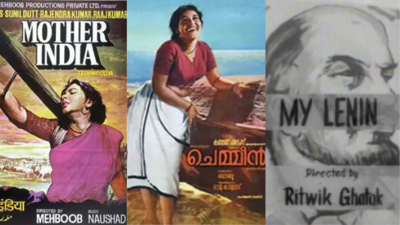- News
- India News
- 78th Independence Day: Golden moments of India's Silver Screen
Trending
78th Independence Day: Golden moments of India's Silver Screen
India's film industry has evolved significantly since 1947, producing notable films such as 'Pather Panchali', 'Sholay', and 'Dilwale Dulhaniya Le Jayenge'. Technological advancements like CGI have revolutionized the industry, exemplified by 'Bahubali'. Recent successes include 'All We Imagine As Light', which marked India's return to the Cannes competition section after 30 years.

NEW DELHI: Since India gained independence in 1947, its film industry has experienced significant evolution and expansion, becoming one of the largest and most influential in the world.
With films like Mother India, Pather Panchali, Pyaasa, Amar Lenin, RRR, All We Imagine As Light, and many more, India has left a strong impact in the global space.
Indian cinema, known for its rich storytelling, diverse genres, and unique styles, has grown from a nascent industry into a global cultural phenomenon.

Here's a look at Indian silver screen's golden moments:
Do Bigha Zameen, 1953: The pauperisation of peasantry pinned down by debt and circumstance is among the unchanging tragedies of modern life. Director Bimal Roy’s ode to neo-realism is about one such wretched family; its slow-motion conversion to the vast urban underclass. Based on writer-composer Salil Chowdhury’s story, the award-winning film draws on a sterling performance from actor Balraj Sahni playing the protagonist throttled by misery.
Pather Panchali, 1955: Movies in India can be divided into pre- and post-Pather Panchali era. Director Satyajit Ray’s sensitive take on idyllic rural Bengal in transition as seen through the lens of a young boy is a masterclass in poetic minimalism. Pather Panchali received the Best Human Document award at Cannes and the national award for best feature film. But more importantly, it ensconced India on the map of world cinema and imprinted an alternative idea of Indian films abroad.
Chemmeen, 1965: Malayalam writer Thakazhi Sivasankara Pillai’s lyrical novel vividly details the lives of fisherfolk in coastal Kerala. Director Ramu Kariat’s celluloid interpretation was welcomed by critics and filmgoers alike. The tragic interfaith love story, with breathtaking photography and memorable music by Salil Chowdhury, received the national award for best feature.
Sholay, 1975: In the seventies, it was common to hear loudspeakers blaring Sholay dialogues. Little surprise, kids remembered them better than nursery rhymes. Marriage rituals would be conducted to the priest’s chants with “Tera kya hoga kaliya” being played on gramophones in the background. In auditoriums, fans would repeat dialogues before the actors spoke them in theatres. Director Ramesh Sippy’s curry western not only broke records of cash collection but also became a benchmark on how movies become part of our life.
Ardh Satya, 1983: New Wave cinema acquired a more urgent and assertive face in the eighties. Ardh Satya, the story of an honest cop who battles against a domineering father, a local tough and his own inner demons, took arthouse cinema to the next level. Om Puri’s bottled rage made Anant Velankar the definitive cinema cop of the decade. Ardh Satya was the magical crossover movie -- a cash-counter biggie and an award collector -- that parallel cinema bhakts dreamt about.
Dilwale Dulhaniya Le Jayenge, 1995: In early 1990s, the Indian economy was liberalised, satellite TV brought American soap and culture to middle-class homes and globalisation rapidly created a dollar-rich NRI market for Hindi cinema. In this rapidly changing economic and cultural universe, Dilwale Dulhaiya Le Jayenge, the love story between two young NRIs, found an affirmative echo. The film forged a blockbuster balance between superficial modernity and feelgood tradition. Almost 30 years later, it’s still running in Bombay’s Maratha Mandir.
Bahubali, 2015: Advancement in Computer Generated Imagery (CGI), a category of VFX (visual effects), revolutionised film technology. Among other things, it took science-fiction and epic adventure to new levels. Director SS Rajamouli’s movie found the sweet centre of the VFX’s potential. The smash hit, released in multiple languages, created a template for a genre that continues.
All We Imagine As Light, 2024: Every year many Indian stars in their shimmery bright walk on the Cannes red carpet. But in the competition section, Indian films couldn’t find a place for 30 years. Until, Payal Kapadia’s All We Imagine As Light, an aesthetically eloquent, multi-layered film about womanhood and the migrant experience, won the Grand Prix in France. The film sets a new benchmark for young filmmakers.
With films like Mother India, Pather Panchali, Pyaasa, Amar Lenin, RRR, All We Imagine As Light, and many more, India has left a strong impact in the global space.
Indian cinema, known for its rich storytelling, diverse genres, and unique styles, has grown from a nascent industry into a global cultural phenomenon.


Here's a look at Indian silver screen's golden moments:
Do Bigha Zameen, 1953: The pauperisation of peasantry pinned down by debt and circumstance is among the unchanging tragedies of modern life. Director Bimal Roy’s ode to neo-realism is about one such wretched family; its slow-motion conversion to the vast urban underclass. Based on writer-composer Salil Chowdhury’s story, the award-winning film draws on a sterling performance from actor Balraj Sahni playing the protagonist throttled by misery.
Pather Panchali, 1955: Movies in India can be divided into pre- and post-Pather Panchali era. Director Satyajit Ray’s sensitive take on idyllic rural Bengal in transition as seen through the lens of a young boy is a masterclass in poetic minimalism. Pather Panchali received the Best Human Document award at Cannes and the national award for best feature film. But more importantly, it ensconced India on the map of world cinema and imprinted an alternative idea of Indian films abroad.
Chemmeen, 1965: Malayalam writer Thakazhi Sivasankara Pillai’s lyrical novel vividly details the lives of fisherfolk in coastal Kerala. Director Ramu Kariat’s celluloid interpretation was welcomed by critics and filmgoers alike. The tragic interfaith love story, with breathtaking photography and memorable music by Salil Chowdhury, received the national award for best feature.
Sholay, 1975: In the seventies, it was common to hear loudspeakers blaring Sholay dialogues. Little surprise, kids remembered them better than nursery rhymes. Marriage rituals would be conducted to the priest’s chants with “Tera kya hoga kaliya” being played on gramophones in the background. In auditoriums, fans would repeat dialogues before the actors spoke them in theatres. Director Ramesh Sippy’s curry western not only broke records of cash collection but also became a benchmark on how movies become part of our life.
Ardh Satya, 1983: New Wave cinema acquired a more urgent and assertive face in the eighties. Ardh Satya, the story of an honest cop who battles against a domineering father, a local tough and his own inner demons, took arthouse cinema to the next level. Om Puri’s bottled rage made Anant Velankar the definitive cinema cop of the decade. Ardh Satya was the magical crossover movie -- a cash-counter biggie and an award collector -- that parallel cinema bhakts dreamt about.
Dilwale Dulhaniya Le Jayenge, 1995: In early 1990s, the Indian economy was liberalised, satellite TV brought American soap and culture to middle-class homes and globalisation rapidly created a dollar-rich NRI market for Hindi cinema. In this rapidly changing economic and cultural universe, Dilwale Dulhaiya Le Jayenge, the love story between two young NRIs, found an affirmative echo. The film forged a blockbuster balance between superficial modernity and feelgood tradition. Almost 30 years later, it’s still running in Bombay’s Maratha Mandir.
Bahubali, 2015: Advancement in Computer Generated Imagery (CGI), a category of VFX (visual effects), revolutionised film technology. Among other things, it took science-fiction and epic adventure to new levels. Director SS Rajamouli’s movie found the sweet centre of the VFX’s potential. The smash hit, released in multiple languages, created a template for a genre that continues.
All We Imagine As Light, 2024: Every year many Indian stars in their shimmery bright walk on the Cannes red carpet. But in the competition section, Indian films couldn’t find a place for 30 years. Until, Payal Kapadia’s All We Imagine As Light, an aesthetically eloquent, multi-layered film about womanhood and the migrant experience, won the Grand Prix in France. The film sets a new benchmark for young filmmakers.
End of Article
FOLLOW US ON SOCIAL MEDIA










